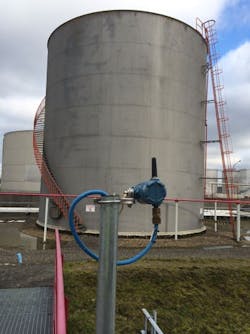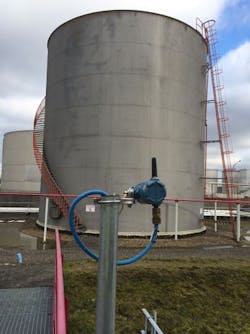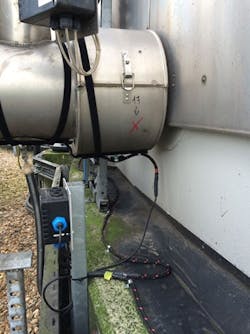Leak detection at large chemical sites can be both difficult and expensive. At one Belgian plant, operators were making twice-daily inspection rounds using portable leak detectors — but new and stricter government regulations required continuous monitoring instead. So, plant management decided to implement an online leak-detection system.
In 2013, after research on suppliers and technology, the plant installed a system that uses hydrocarbon fast-fuel sensors and sensor cables, and wireless discrete transmitters. An IEC-standard WirelessHART field network communicates leakage data from the remote transmitters to the plant control system.
Figure 1. Leak detection system relies on discrete wireless transmitters to send data from sensors and sensor cables that detect xylene and benzene.
The leak detection project saved around 60% compared to a conventional wired approach. Moreover, the system took only one day to commission. Besides ensuring compliance with regulations, the installation has enabled the plant to expand the operators’ view and has enhanced its existing leak-detection practices, helping to improve site safety.
Project Challenges
The main triggers for implementing real-time leak detection were the flammable nature of the product itself and the desire to reduce compliance issues, increase employee safety and provide constant monitoring of the plant’s condition. There were some obvious challenges:
• difficulty in detecting/monitoring hydrocarbon leaks around tanks, valves and pipe flanges;
• absence of installed instruments on tanks to detect abnormal changes in level due to leaks;
• fluctuation of tank level with changes in process demand; and
• lack of ready-to-use options to detect leaks at valves and flanges.
The plant’s management wanted to avoid the issues posed by traditional wired online monitoring, e.g., requirements for extensive cabling, together with the associated input/output, signal converters and installation costs. So, an evaluation team began a search to select the right supplier and technology. It reviewed different vendors and then tested a number of potentially viable available options:
• gas detection using a catalytic probe;
• an optical monitoring system (spectral analysis);
• an analyzer for lower explosion limit (LEL) detection;
• WirelessHART hydrocarbon leak detection; or
• WirelessHART fast fuel sensors for leak detection.
The team found most promising an approach that integrated sensors that detect liquid hydrocarbons with WirelessHART communications technology. It put that option through further laboratory trials with simulated leaks. Successful test results prompted a decision to implement that approach at the plant.
Figure 2. Sensor cables are placed on the concrete base surrounding a tank as well as underneath connecting piping and around tank flanges, valves and manholes.
The leak detection system uses eleven Rosemount 702 wireless discrete transmitters from Emerson (Figure 1) in combination with Pentair (formerly Tyco) fast fuel sensors and TraceTek sensor cables. When one of the sensors detects xylene or benzene, the associated Rosemount 702 wirelessly transmits an alarm signal to a Smart Wireless Gateway for relay to the control room where operators monitor and record the status for accurate incident reporting and time stamping in the host control system. The 702 discrete input/output devices are part of IEC-standard WirelessHART field networks.
The TraceTek sensor cables are attached to the concrete bases surrounding tanks to detect leaks from the tank wall (Figure 2). They also are laid underneath connecting piping and draped around the tank flanges and manholes as well as valves. The fast fuel sensors detect hydrocarbons in sump wells and pump skids. Leaking xylene or benzene upon touching the sensor cable or sensor completes a circuit. This sends a discrete input to the 702 input/output device that transmits it wirelessly to a gateway that relays data to the control room.
Impressive Results
The plant team found that wireless technology provides a reliable, affordable way to gather information from hydrocarbon sensors that continuously monitor storage tanks, valves and pipelines throughout the plant, and to deliver that information to the control system to notify operators of any leaks. This automated monitoring system has enabled the site to meet the latest government regulations for storage and handling of flammable liquids.
Installation by the plant’s maintenance team was quick and easy. Smart Wireless technology eliminated the need for new instrumentation cabling and associated trenches and ducting, saving an estimated 50% of the cost and 90% of the time required to put in a conventional wired system.
Combining Emerson’s wireless technology with hydrocarbon sensors and sensing cable has provided effective leak detection for the large site. It illustrates how a plant can take advantage of wireless technology to gain business benefits — including enhanced safety and regulatory compliance — in applications beyond the process itself.
BOB KARSCHNIA is vice president of wireless for Emerson Process Management, Shakopee, Minn. E-mail him at [email protected].


